QtSpim使用Tips
QtSpim使用记录
垃圾QtSpim,输入中文会死机
MIPS的中文资料奇缺,如果有问题建议google参考英文资料,许多外国大学的网站上有对MIPS各方面的详细介绍


QtSpim是MIPS处理器的模拟器,它的编辑环境并不是太好,一般另外找编辑器进行编辑。
Data标签下存放数据段的数据,Text标签下存放代码段代码,
The assembly process occurs as the file is being loaded. As such, any assembly syntax
errors (i.e., misspelled instructions, undefined variables, etc.) are caught at this point.
An appropriate error message is provided with a reference to the line number that
caused the error.
When the file load is completed with no errors, the program is ready to run, but has not
yet been executed. The screen will appear something like the following image.
其实当文件载入的时候语法分析就已经完成了,如果有语法错误会报错,没报错就是通过语法分析了。
The code is placed in Text Window. The first column of hex values (in the []'s) is the
address of that line of code. The next hex value is the OpCode or hex value of the 1's
and 0's that the CPU understands to be that instruction.MIPS includes pseudo-instructions. That is an instruction that the CPU does not
execute, but the programmer is allowed to use. The assembler, QtSpim here, accepts the
instruction and inserts the real or bare instruction as appropriate
上述两个引用都来自于:http://www.egr.unlv.edu/~ed/MIPStextSMv11.pdf
text下第四栏是我们写的MIPS伪指令,而第三列是伪指令翻译成的真实的CPU指令,第二列是这些指令在内存中的储存结果,第一列是内存地址(指的是第一个字节位,从低到高)
你说这对于programmer有什么用?2333对于初学者而已好像确实没什么用,但是起码人家把最底层的盖子完完整整地掀开了。
Data项用一个图就能说明:
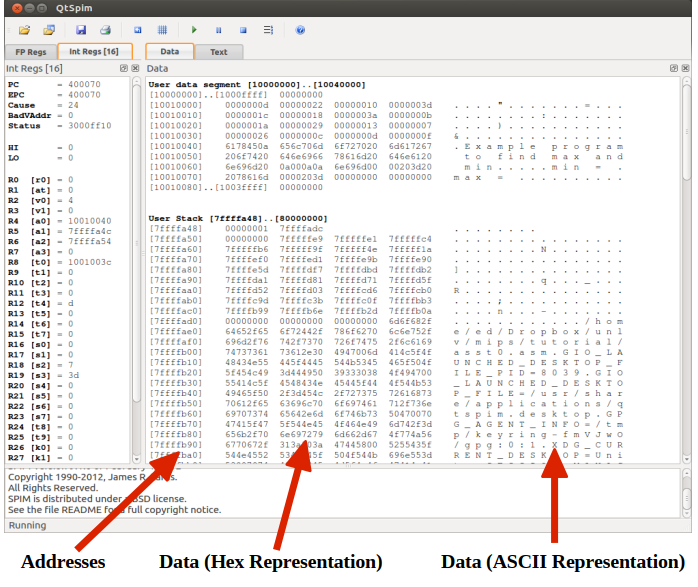
各个寄存器的作用:
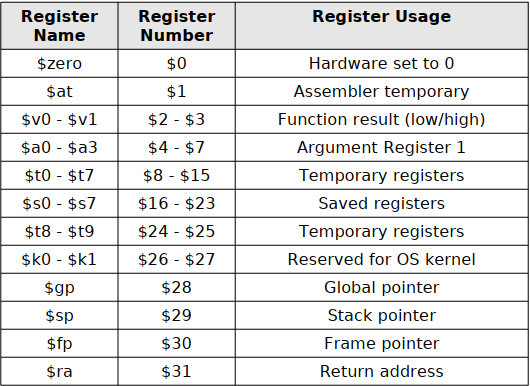


MIPS各段的含义:
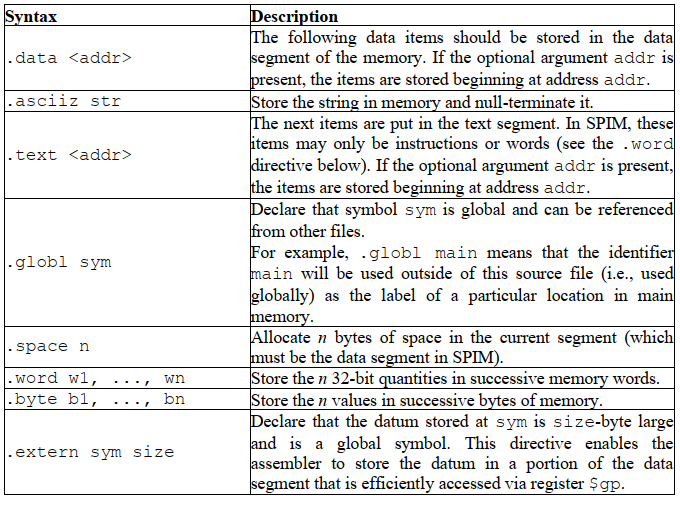
注意这里不是global,而是globl,少了一个a2333
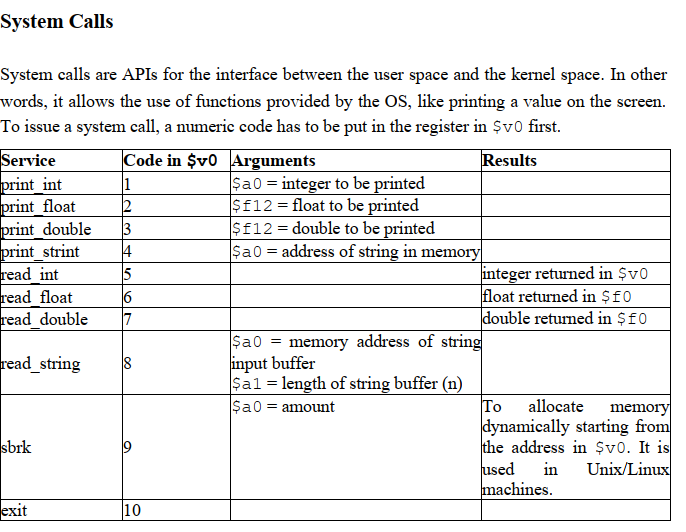
注意,System calls的操作数都必须放在$v0中,数据往往放置在a0中(也有例外,例如表中的print_float和print_double)
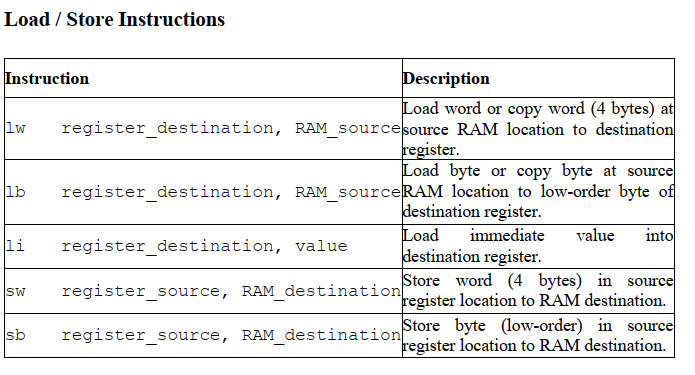
l开头的是从内存加载到寄存器,s开头的是从寄存器写入到内存
还有一个这里没有提到,就是la:load address,对于string(当然这里string是用asciiz表示的)常常是这样操作

第一个寄存器是结果储存位置,之后的是计算所需的

指令备忘
SLT:
R1起到了flag的作用
BEQ:

j:

如何在MIPS中写if else语句?

if else框架:
高级语言描述
if(a<b)
c=1;
else
c=2;
MISP描述:
a,b,c分别存放在$v2\$v3\$v4中,$0中存放0(这个是固定的)
slt $5,$2,$3//如果$2<$3,$5中为1
beg $5,$0,Else//通向else
li $v4,1
j Endif
Else:
li $v4,2
Endif:
如何退出程序?
li $v0 10 # 退出
syscall

如何写函数?
.text
main:
li $t0, 1
jal procedure # call procedure
li $v0, 10
syscall
procedure:
li $t0, 3
jr $ra # return
如何声明数组?
Code Implementations Dealing with Arrays
Here are several examples, to promote understanding of how assembly language implements code that deals with arrays.
1-Dimensional Arrays
Declarations
One way to declare an array of 13 characters:
my_chars: .byte 0:13
What was the initial value of each of these declared array elements? Answer: The null character (
'\0'in C).An alternative way to declare the array of 13 characters:
my_chars: .space 13
What is the difference between these two declarations? Answer: The first way initializes this declared memory space before the program begins execution. The second way (with the
.spacedirective) does not initialize memory. It allocates the 13 bytes, but does not change their contents before the program begins its execution.And if we wanted to declare the array of 13 characters, but initialize each character to the value
'A'?:my_As: .byte 'A':13
Alternatively:
my_As: .byte 65:13
This second way works fine, but may be less clear to a programmer looking at the code. This second way initializes each byte of the array to contain the 8-bit, two's complement representation for the decimal value 65. Since that is the ASCII character encoding for
'A', it works equally well.To declare an array of integer-sized elements, recall that on the MIPS architecture, each integer requires 4 bytes (or 32 bits). Also, each word on the MIPS architecture is 4 bytes. Therefore, we may use the
.worddirective to declare an array of integers:int_array: .word 0:36
This declaration allocates 36 words (integer-sized memory chunks), which are all (nicely) located at word-aligned addresses. The initial value of each array element is 0.
If, instead, we wanted an array of 36 integers, where each element is initialized to the value 2, we may use:
all_twos: .word 2:36
The
.spacedirective might be used to declare an array of integer-sized elements, but can be problematic. Consider the declaration:array: .space 100
25 integer-sized elements are allocated as desired, but there is no guarantee that each of the elements are at word-aligned addresses. Therefore, this declaration plus code that does
la $8, array
lw $9, 12($8) # load the 4th element of the array
may result in an unaligned address exception when the program executes.
A related declaration issue that is beyond the scope of this class is the alignment of data within an array, when each element contains more than a single field. An example from the C is an array of structures, where each structure has more than one field. The difficulty of the allocation may be seen with the sample structure:
struct fivebytes {
int oneint;
char onechar;
} fivebytes array[10];
Code to work with elements of this array makes it difficult to load/store the integer-sized, and non-word aligned
oneintCode
Assembly language code (high level language code, too!) that does array access may be generally classified as doing either regular accesses or random accesses. A regular access is one that might be stated such as "for each element of the array, do something." Or, "for every 3rd element of the array, do something." A random access is more of an isolated element access similar to the C code:
int array[12]; /* declare an array of 12 integers */
int x; x = 4;
array[x] = -23;
The code that does a random array element access tends to follow a fixed pattern (a series of steps), as generated by a compiler.
- Get the base address of the array.
- Calculate an offset by multiplying the array index by the size of each element (in bytes on the MIPS architecture, which is byte addressible).
- Add the base address to the offset, to form the address of the desired array element.
- Load or store to the desired element using the calculated address.
Here is a MIPS assembly language implementation of the C code fragment for the isolated (random) element access:
.data
array: .word 0:12 # array of 12 integers .text
li $8, 4 # $8 is the index, and variable x
la $9, array # $9 is the base address of the array
mul $10, $8, 4 # $10 is the offset
add $11, $10, $9 # $11 is the address of array[4]
li $12, -23 # $12 is the value -23, to be put in array[4]
sw $12, ($11)
A regular access will be done within a structured loop. Once the address of the initial element is calculated, further array element addresses are calculated relative to the known one. Only the address changes. This reduces the amount of code necessary within the loop, which results in fewer instructions executed and (therefore) faster code.
Consider the implementation of a code example that is to re-initialize each element of an array of 100 integers to be the value 18. A less efficient implementation places the isolated element access code into a loop. This implementation tries to use the same registers for clarity of the example.
.data
array: .word 0:100 # array of 100 integers .text
li $8, 0 # $8 is the index, and loop induction variable
li $13, 100 # $13 is the sentinel value for the loop
for: bge $8, $13, end_for
la $9, array # $9 is the base address of the array
mul $10, $8, 4 # $10 is the offset
add $11, $10, $9 # $11 is the address of desired element
li $12, 18 # $12 is the value 18, to be put in desired element
sw $12, ($11)
add $8, $8, 1 # increment loop induction variable
b for
end_for:
More efficient code to do the same thing increments only the address of the desired element within the loop. As many instructions as possible are removed from within the loop.
.data
array: .word 0:100 # array of 100 integers .text
li $8, 0 # $8 is the loop induction variable
li $13, 100 # $13 is the sentinal value for the loop
la $9, array # $9 starts as the base address of the array
# and is the address of each element
li $12, 18 # $12 is the value 18, to be put in desired element
for: bge $8, $13, end_for
sw $12, ($9)
add $9, $9, 4 # get address of next array element
add $8, $8, 1 # increment loop induction variable
b for
end_for:
This code might be made even more efficient by eliminating the loop induction variable ($8), instead calculating the address of the last element and using it to decide when to exit the loop. Note that this eliminates a single instruction from within the body of the loop.
2-Dimensional Arrays
There is little formal syntax (in assembly language) to declare or use a 2-dimensional array. Therefore, implementations vary. Here are some MIPS examples to suggest 2-dimensional array implementations.
Declarations
Without a formalized syntax, a declaration of a 2-dimensional array reduces to the allocation of the correct amount of contiguous memory. The base address identifies the first element of the first row within the first column.
Consider the declaration of an example 2 by 3 array of characters. Each character requires one byte.
chars: .space 6 # 2 by 3 = 6 bytes of allocated space
This is not a satisifying declaration for the abstract thinker, as this declaration might represent a 3 by 2 array, or a 1-dimensional array of 6 characters. The burden is on the programmer to declare the necessary memory space, and then use that space in a consistent manner.
An alternative in MIPS assembly language code allocates a set of arrays. For example, consider a 4 by 6 array of integers, where each element is initialized to the value 18.
arr: .word 18:6
.word 18:6
.word 18:6
.word 18:6
This declaration conveys the notion of an array of arrays.
Code
Issues with code that operates on a 2-dimensional array are the same as those with 1-dimensional arrays, with the added point of storage order. A 2-dimensional array may be stored in either row major order or column major order.
If 2-dimensional array is thought of as an array of 1-dimensional arrays, then operating on one row of a row major ordered array is fairly simple. Likewise, operating on one column of a column major ordered array is fairly simple.
附上两个非常有帮助的网站:
- https://e-mailky.github.io/2017-09-07-mips_instruction。提供了一个表来查找命令的中文解释
- https://www.cs.fsu.edu/~hawkes/cda3101lects/chap3/ifthenelse.html。提供了一些和MIPS相关的指导
QtSpim使用Tips的更多相关文章
- Mac上MySQL忘记root密码且没有权限的处理办法&workbench的一些tips (转)
忘记Root密码肿么办 Mac上安装MySQL就不多说了,去mysql的官网上下载最新的mysql包以及workbench,先安装哪个影响都不大.如果你是第一次安装,在mysql安装完成之后,会弹出来 ...
- 【Tips】史上最全H1B问题合辑——保持H1B身份终级篇
[Tips]史上最全H1B问题合辑——保持H1B身份终级篇 2015-04-10留学小助手留学小助手 留学小助手 微信号 liuxue_xiaozhushou 功能介绍 提供最真实全面的留学干货,帮您 ...
- layer.js中layer.tips
<script src="~/Content/js/layer/layer.js"></script> layer.tips('名称不能为空', '#pro ...
- HTML 最简单的tips 怎么支持指定DIV显示提示信息
<body> <style type="text/css"> a.link{position:relative;} a.link div.tips{ bor ...
- CSS:CSS使用Tips
Css是前端开发中效果展现的主要部分之一,良好的Css书写习惯可以为实际的项目开发提高效率,也可以为实现良好的团队合作提供保证. 一般新手在使用Css的时候经常会犯一些错误,出现一些不经意的漏洞,如果 ...
- 【读书笔记】100个Switf必备tips
声明 欢迎转载,但请保留文章原始出处:) 博客园:http://www.cnblogs.com 农民伯伯: http://over140.cnblogs.com 正文 1.Selector 在Swi ...
- 【转】40个良好用户界面Tips
一个良好的用户界面应具有高转换率,并且易于使用.但要用户体验良好并不容易做到,下面我们整理了40个良好用户界面Tips,希望能对你有帮助! 1 尽量使用单列而不是多列布局 单列布局能够让对全局有更好的 ...
- 转:Eclipse Search Tips
from: https://github.com/ajermakovics/eclipse-instasearch/wiki/Eclipse-search-tips Eclipse Search T ...
- VS:101 Visual Studio 2010 Tips
101 Visual Studio 2010 Tips Tip #1 How to not accidentally copy a blank line TO – Text Editor ...
随机推荐
- JS框架_(JQuery.js)上传进度条
百度云盘 传送门 密码: 1pou 纯CSS上传进度条效果: <!DOCTYPE html PUBLIC "-//W3C//DTD XHTML 1.0 Transitional//EN ...
- sqli-libs(2)
Lesson2:数字型注入我们先来测试一下 http://127.0.0.1/sql1/Less-2/?id=1%20and%201=1 发现未报错 这里知道我们的数字型注入是不需要 进行单引号闭合的 ...
- C++入门经典-例3.12-使用if-else语句实现根据输入的字符输出字符串
1:代码如下: // 3.12.cpp : 定义控制台应用程序的入口点. // #include "stdafx.h" #include <iostream> usin ...
- spark streaming 3: Receiver 到 submitJobSet
对于spark streaming来说,receiver是数据的源头.spark streaming的框架上,将receiver替换spark-core的以磁盘为数据源的做法,但是数据源(如监听某个 ...
- leetcode 166分数到小数
手动排除特殊情况: 对于一般情况,使用位运算和加减法来计算除法,使用sign记录结果符号:(这部分为leetcode 29题的答案) 使用hashmap来记录循环体出现的开始位置(如果有的话),使用f ...
- 由MySQL登录不了引发的一些问题
经手的项目按照老板的意思,想搞一个类似于个人学习版的版本给客户试用.计划通过网络将安装包发布出去,让客户自行下载安装使用,碰到个问题:数据库的安装.因为后台使用了MS SQLServer 2008/2 ...
- java的replace和replaceAll
都是全部替换,只不过后者参数为正则 replaceFirst()是替换第一个
- jqGrid细节备注—jqGrid中自定义格式,URL格式
本文来自:http://cnn237111.blog.51cto.com/2359144/782137 jqGrid中自定义格式,URL格式 当官方自带的showlink用起来不是十分顺手,因此可以考 ...
- Selenium 2自动化测试实战21【调用JavaScript(控制浏览器的滚动条)】
一.调用JavaScript(控制浏览器的滚动条) WebDriver提供了execute_script()方法来执行JavaScript代码.用于调整浏览器滚动条位置的JavaScript代码如下 ...
- 【汇总】Windows linux 敏感目录 路径汇总
日期:2019-08-02 10:53:52 更新:2019-08-19 15:48:01 作者:Bay0net 介绍:中间件.套件等等敏感信息,做个记录. 0x01. 基本信息 遇到文件包含.任意文 ...
